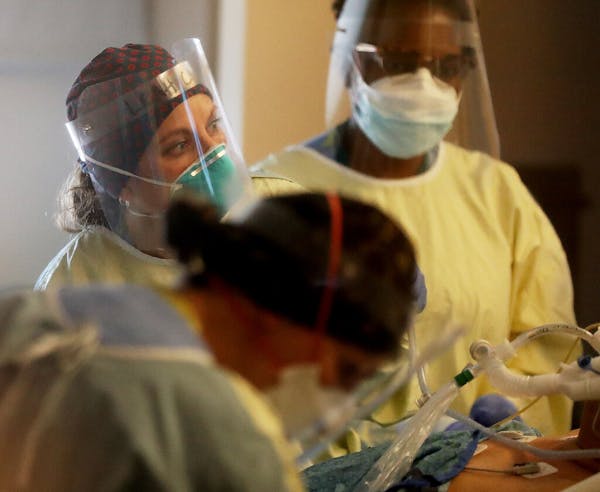Minnesota reported single-day records of COVID-19 hospitalizations and newly diagnosed infections on Thursday, marks that aren't likely to stand for long as the pandemic continues to spread, the state's health commissioner predicted.
The addition of 2,872 confirmed and probable infections and 32 deaths brought Minnesota's pandemic totals to 142,311 infections and 2,419 deaths. Daily infection totals have surpassed 2,000 four times in the past two weeks.
"Two thousand and more is becoming our new norm," Health Commissioner Jan Malcolm said, "and I think we need to brace ourselves for days with bigger totals yet to come."
Most people infected by the novel coronavirus that causes COVID-19 suffer mild or no symptoms, but the rising volume of lab-confirmed cases increases the threat of it spreading to older people at greater risk, long-term care facilities with vulnerable populations, and health care workers who can't afford absences amid a pandemic.
State health officials said this week that they have been eyeing new strategies, including changes to further protect long-term care residents — who have suffered 70% of the state's COVID-19 deaths. Rapid testing will soon be targeted at asymptomatic young adults to track the unseen spread of the infection. New predictive modeling from the University of Minnesota also is coming soon to assess how changes in response to the pandemic could affect its growth.
On Thursday, though, health officials implored people to stick with the basics of mask-wearing, social distancing, covering coughs and staying home when sick to protect others around them.
"We know how that spread impacts and threatens so many sensitive areas of our society from hospitals and clinics to nursing homes and assisted-living facilities," said Kris Ehresmann, state infectious disease director. "This is a problem that requires the attention of each and every Minnesotan."
Infection numbers have increased somewhat due to broader molecular diagnostic testing, with the state opening its sixth free saliva-testing site in St. Cloud on Wednesday and its seventh in St. Paul on Friday. Rapid antigen testing is being used more as well, though its positive results are classified by the state as probable because of a slightly lower accuracy rate.
However, health officials said the current case growth is due to actual broadening spread of the virus — with 83 of Minnesota's 87 counties reporting infections Thursday. The positivity rate of testing has risen to nearly 7%.
Ehresmann said Minnesota is starting to look like the Dakotas and Wisconsin looked weeks ago. The COVID Exit Strategy website lists the Dakotas with the nation's highest rates of more than 1,000 new infections per million people per day; Wisconsin's rate is 721 and Minnesota's is 326.
"We're looking with concern at where our neighbors have been and the direction that we're going," she said. "There's a little bit too much overlap between the two."
Rising case counts flipped six more Minnesota counties into the category in which all-online learning would be recommended at schools. Twenty-five mostly rural counties have high enough infection levels for that recommendation, while 37 have levels that recommend all online classes in middle schools and high schools and hybrid instruction in elementary schools.
Anoka, Ramsey and Washington counties fall into that latter advisory category.
Malcolm said the state reached a record with 685 Minnesotans with COVID-19 admitted to U.S. hospitals, including 168 people who needed intensive care. The ICU total was not a record.
The state's pandemic dashboard showed Minnesota hospitals have some excess capacity — with 1,120 of 1,521 immediately available ICU beds filled with patients due to COVID-19 or other unrelated medical concerns.
Malcolm said she has received reports that hospitals have opened some standby ICU beds in response to demand. Even so, the dashboard lists another 408 ICU beds that could be readied within 72 hours.
Hospital leaders report better preparedness now compared with the last surge of COVID-19 admissions in the spring.
Hospital outcomes have improved with better oxygen management techniques and therapeutics such as the antiviral remdesivir and the steroid dexamethasone. A state review of hospital outcomes shows a decline in mortality from 15% in mid-May to 10% now. The median length of stay also has declined.
Thursday's report of 32 more COVID-19 deaths included five people younger than 70. More than 80% of the deaths in Minnesota so far have involved people 70 or older.
The daily death total was one of the highest in the pandemic. However, Wednesday and Thursday Health Department reports this fall have tended to include higher fatality numbers — possibly reflecting administrative delays of verifying and then reporting COVID-19 deaths during the workweek.
Regardless, the 118 deaths reported in the seven-day period ending Thursday is one of the highest totals since early June.
Jeremy Olson • 612-673-7744

Teen suspect in Nudieland mass shooting arrested on murder, assault charges
'Human error' behind Robbinsdale shelter-in-place alert that was mistakenly sent countywide

Going to Wolves or Twins tonight? How to get there (and maybe avoid traffic).
Focusing on bringing football film into frame

